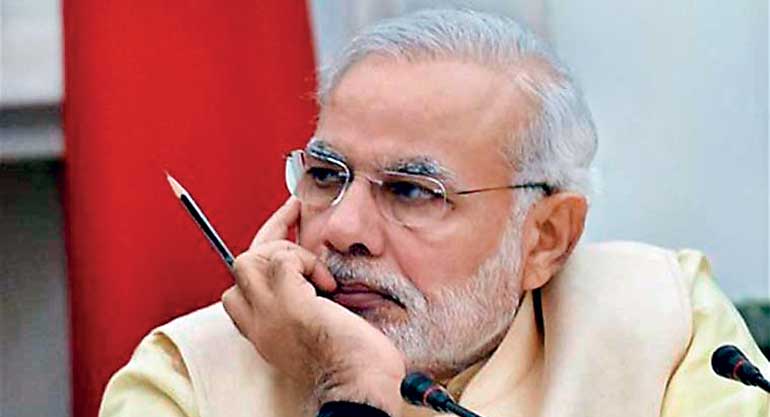Friday Feb 21, 2025
Friday Feb 21, 2025
Wednesday, 9 September 2015 00:00 - - {{hitsCtrl.values.hits}}

Prime Minister Narendra Modi called bankers and billionaires to his residence on Tuesday to brainstorm on how India can manage global economic turbulence, including opportunities for Asia’s third-largest economy in China’s market and growth woes.
The morning meeting in New Delhi was attended by tycoons including India’s richest man, Mukesh Ambani, Finance Minister Arun Jaitley, central bank governor Raghuram Rajan, economists and state and private bank chiefs.
At the gathering, industry chamber ASSOCHAM told Modi policy makers needed to act fast to “bullet proof” India from global jitters – calling for a deep cut in interest rates and new duties to stop dumping of Chinese products such as steel.
India’s macroeconomic situation has improved considerably since the “taper tantrum” of 2013, not least thanks to lower prices for the commodities it imports. Then, inflation, for example, was at double digits - it has since halved.
The International Monetary Fund considers India’s economy a rare bright spot among emerging markets and Modi sees a chance to attract more foreign investment as money flows out of China.
But it will not be easy to turn China’s pain into India’s gain. Investors and corporates increasingly worry that Modi has not moved fast enough since taking office. Annual growth slowed to 7% in the June quarter.
“Modi ran a successful state. He campaigned for 2 years saying he knew what to do. He has been there 15 months with the largest majority since independence yet little has happened,” US investor Jim Rogers told Reuters Trading India on Tuesday.
Rogers recently announced he had sold his India investments.
After farmer protests forced the government to drop a major land reform and opposition parties delayed a growth-boosting tax overhaul, expectations are growing that Modi will soon unveil new measures to make it easier for foreign money to enter India.
The government predicts India’s economy will grow at 8% or more in 2015/16, prodded by government spending. Yet private investment has been slow to pick up, with banks and businesses hobbled by bad debts and high lending rates. In the real economy, there are few signs of a major economic recovery. In the construction and diamond polishing industries, for example, there have been large layoffs.
ASSOCHAM called on central bank chief Raghuram Rajan to slash interest rates by up to 1.25 percentage points by March to help revive investment and growth.
Discover Kapruka, the leading online shopping platform in Sri Lanka, where you can conveniently send Gifts and Flowers to your loved ones for any event including Valentine ’s Day. Explore a wide range of popular Shopping Categories on Kapruka, including Toys, Groceries, Electronics, Birthday Cakes, Fruits, Chocolates, Flower Bouquets, Clothing, Watches, Lingerie, Gift Sets and Jewellery. Also if you’re interested in selling with Kapruka, Partner Central by Kapruka is the best solution to start with. Moreover, through Kapruka Global Shop, you can also enjoy the convenience of purchasing products from renowned platforms like Amazon and eBay and have them delivered to Sri Lanka.
Discover Kapruka, the leading online shopping platform in Sri Lanka, where you can conveniently send Gifts and Flowers to your loved ones for any event including Valentine ’s Day. Explore a wide range of popular Shopping Categories on Kapruka, including Toys, Groceries, Electronics, Birthday Cakes, Fruits, Chocolates, Flower Bouquets, Clothing, Watches, Lingerie, Gift Sets and Jewellery. Also if you’re interested in selling with Kapruka, Partner Central by Kapruka is the best solution to start with. Moreover, through Kapruka Global Shop, you can also enjoy the convenience of purchasing products from renowned platforms like Amazon and eBay and have them delivered to Sri Lanka.